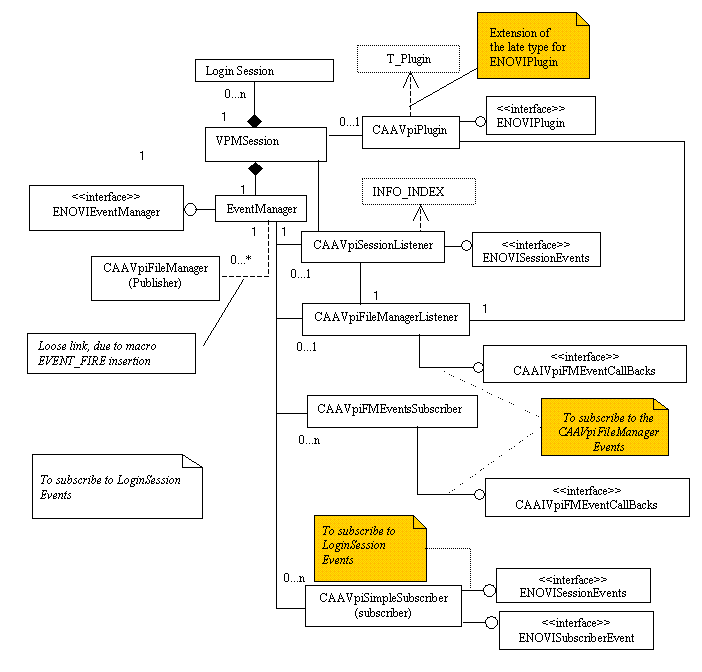3D PLM Enterprise Architecture |
Middleware Abstraction - ENOVIA Event Model |
ENOVIA Event Use Case OverviewWorking with events, publishers and subscribers |
| Use Case | ||
AbstractThis article discusses the Event Model use cases. It explains the classes which are common to the 4 existing uses Cases. |
This article describes the basic classes and notions which will be used in the four use cases dealing with event model and publish/subscribe notions. Some classes are used in more than one use case, and the article details them:
[Top]
The Use Cases presented in this education framework require that a data domain named "INDEX" exists in LCA. By default, no such domain exists. Hence, for the following Use Cases to run properly, your installation has to be customized to include this data domain in the runtime environment.
For this purpose, a metadata file named "CAA_INDEX.metadata" is delivered in the directory "InstallRootDirectory/CAADoc/CAAVPMInterfaces.edu/CNext/resources".
This file defines two entities "Part" and "Document" in the data domain "INDEX". These entities are created and manipulated by the following Use Cases located in the present education framework:
To customize your environment, you have first to create a new framework named "INDEX" under your workspace root directory along with the following file tree:
INDEX -> CNext -> code -> dictionary
INDEX -> CNext -> reffiles -> DBMS -> Generator
Copy the metadata file "CAA_INDEX.metadata" to the newly created directory "RootDirectory/INDEX/CNext/code/dictionary", and rename it "INDEX.metadata".
Copy the param file "CAA_INDEX.param" to the newly created directory "RootDirectory/INDEX/CNext/reffiles/DBMS/Generator", and rename it "INDEX.param".
Then you have to publish and deploy this customization in your runtime environment using the Data Model Customizer RADE Tool.
Refer to the technical article concerning DMC for ENOVIA LCA to learn how to do it. Finally, check that the file "INDEX.metadata" exists now in the directory "OS_a/code/dictionary" of your runtime environment.
Under directory "InstallRootDirectory/CAADoc/CAAVPMInterfaces.edu/CNext/resources", you will also find an event file named "CAA_INDEX.event" which declares the events related to the data domain "INDEX".
For the following Use Cases to run properly, you have to copy this event file to the directory "OS_a/reffiles" of your runtime environment, and rename it "INDEX.event".
Note that you could alternatively copy the file to the directory "RootDirectory/INDEX/CNext/reffiles" (to be created), rename it, and update the runtime view.
This is the final step of the Customization Requirements.
[Top]
This UML diagram represents all the classes involved in the four use cases delivered for illustrating the ENOVIA event model capabilities.

[Top]
In the event use cases, there are four different kinds of classes to be precised.
| Standard classes | The Event Manager, the Session and the Login Sessions |
| Publisher class | The CAAVpiFileManager |
| Subscriber classes | The CAAVpiSimpleSubscriber, the CAAVpiFMEventsSubscriber, and the CAAVpiFileManagerListener |
| Automatic listener classes | The CAAVpiSessionListener and the CAAVpiPlugin |
In each use case, an ENOVIA Session must be created and opened, and to be able to work further, a login session must be opened too (attached to 1 user). To be able to subscribe to events, people must get the object which manages the event model: a query on the Session gives an ENOVIEventManager interface pointer, and using it, you will be able to perform subscriptions and get information on events. There usually is one Event Manager per ENOVIA session while there can be more than one Login Session per ENOVIA session.
The CAAVpiFileManager class is used in 3 of the 4 events use cases : it raises events that the CAAVpiFMEventsSubscriber and the CAAVpiFileManager classes can subscribe to , by implementing the associated CAAIVpiFMCallback interface.
To raise events, CAAVpiFileManager uses an EVENT_FIRE macro (see [2]) which implies an indirect and hidden link with the event manager class . In the different use cases the CAAVpiFileManager instances will have methods called, which raise events, so that potential subscribers receive messages .
The UML diagram shows three "simple" subscriber classes, each of them being used in one single use case.
The CAAVpiAutomaticSubscription and CAAVpiPackageSubscription use cases show 2 different mechanisms of automatic subscription when the creation of a login session is involved.
Here, the CAAVpiSessionListener extends a late Type INFO_INDEX, associated to the test ENOVIA Domain "INDEX" and implements ENOVISessionEvents interface.When it's called back at loginsession creation time, it instanciates the CAAVpiFileManagerListener and makes subscriptions to events raiseable by the CAAVpiFileManager objects.
[Top]
The following table shows the use of the different classes in the use cases.
| Classes | Use Case 1 | Use Case 2 | Use Case 3 | Use Case 4 |
| CAAVpiSimpleSubscriber | X | |||
| CAAVpiFMEventsSubscriber | X | |||
| CAAVpiFileManager | X | X | X | |
| CAAVpiPlugin | X | |||
| CAAVpiSessionListener | X |
[Top]
This article has introduced the common notions of the four use cases describing events model. To go further refer to the detailed four use cases.
[Top]
| [1] | Building and Launching a CAA V5 Use Case |
| [2] | The ENOVIA Event Model |
| [Top] | |
| Version: 1 [Oct 2001] | Document created |
| [Top] | |
Copyright © 2001, Dassault Systèmes. All rights reserved.